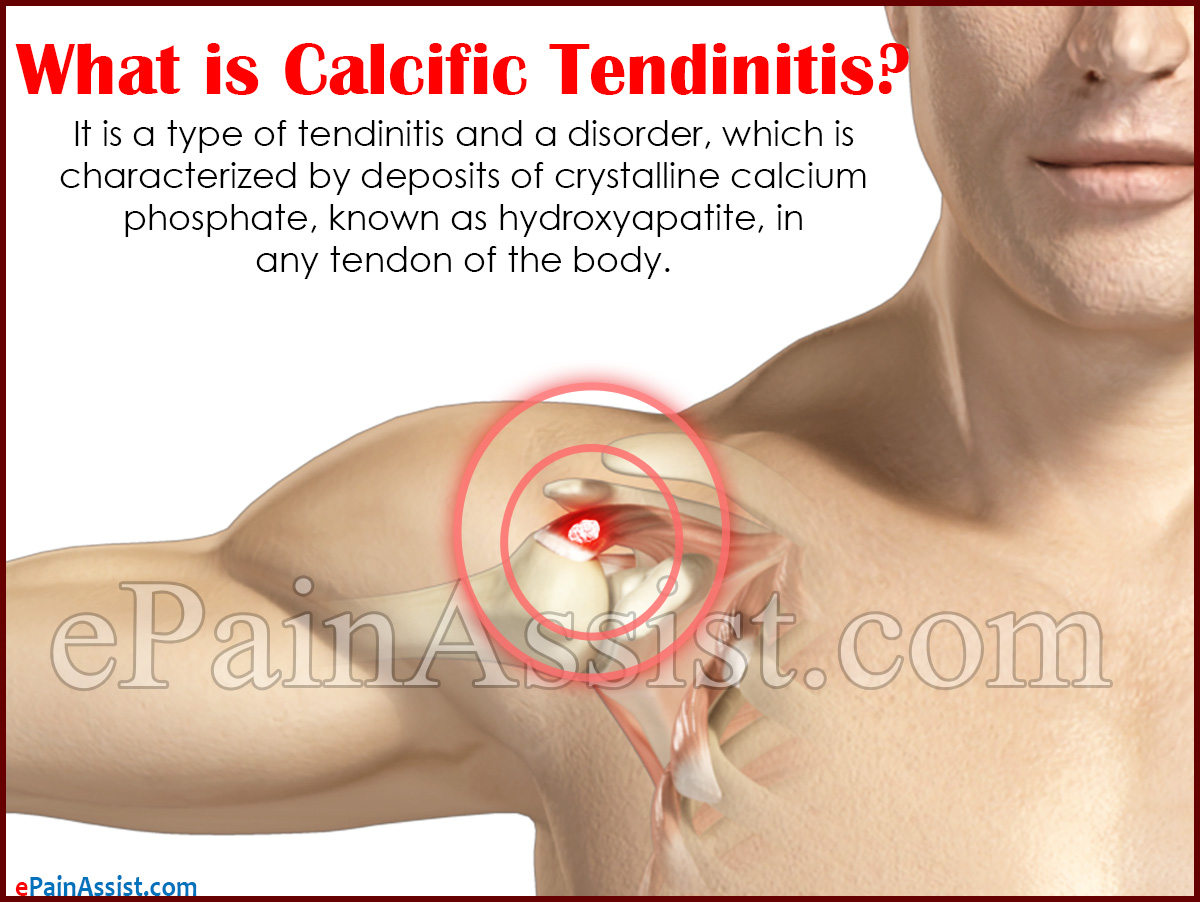What is Calcific Tendinitis?
Calcific tendinitis (calcific/ calcified/ calcifying/calcareous tendinitis/ tendinopathy/ tendonitis/, hydroxyapatite deposition disease (HADD), tendinosis calcarea/ calcific periarthritis), is a type of tendinitis and a disorder, which is characterized by deposits of crystalline calcium phosphate, known as hydroxyapatite, in any tendon of the body.1 However, the most commonly affected tendon is the rotator cuff tendon present in the shoulder. This condition is associated with adhesive capsulitis (frozen shoulder) and also may lead to it. The main symptoms of calcific tendinitis comprise of pain and inflammation.

Treatment of Calcific Tendinitis consists of restriction of dietary calcium, steroid injections, pain killers, extracorporeal shock wave therapy, physical therapy and surgery.
Signs & Symptoms of Calcific Tendinitis
As mentioned above, the main symptoms of calcific tendinitis are pain and inflammation in the region of the affected tendon, particularly in the shoulder.
- Yet another symptom of calcific tendinitis is that the pain is worsened if the arm is elevated above the level of the shoulder.
- Pain associated with calcific tendinitis also worsens if the patient lies on his/her shoulder.2
- There also may be snapping, stiffness, catching, or weakness of the shoulder.
- Pain can be sometimes so acute that it can awaken the patient from sleep.
Causes of Calcific Tendinitis
According to research, there are 3 main theories, which can explain the mechanisms behind the calcification of the tendons.
- According to the first theory, there is reactive calcification which comprises of an active cell-mediated process, after which there is spontaneous resorption by phagocytosing multinucleated cells, which indicate a osteoclast phenotype.
- According to the second theory, the formation of calcium deposits occurs as a result of a process similar to endochondral ossification. Regional hypoxia is the mechanism involving the formation of chondrocytes from tenocytes.
- The third theory suggests the formation of ectopic bone from metaplasia of the mesenchymal stem cells, which are normally found in the tendon tissue into osteogenic cells.
As of now not a single theory is found to be satisfactory, which can explain all the cases, hence calcific tendinitis is presently thought to be multifactorial.
Diagnosis of Calcific Tendinitis
X-rays shows the calcific deposits as cloudy areas or discrete lumps.2 The cloudy appearance occurs if the deposits are in the process of reabsorption, and this is the stage when the patient feels the maximum pain. In the resting stage of the deposits, they appear crystalline. In the reabsorptive stage, they are like toothpaste in appearance. However, there is a poor correlation between the appearance of a calcific deposit on plain x-rays and the consistency felt upon needling. Ultrasound is also helpful in visualizing the calcific deposits which closely correlates with the disease stage.
Treatment for Calcific Tendinitis
- Restriction on Dietary Calcium: This is a conservative method of treatment which is quite effective in some patients suffering from calcific tendinitis where there is alleviation of pain with strict restriction on dietary calcium . The restriction of dietary calcium is applicable to all milk products, calcium-fortified products, nuts with high calcium content and high calcium vegetables and snacks. Reading the food nutritional labels helps in determining which foods to avoid. If there is no improvement in calcific tendinitis with this treatment method, then other treatments should be tried.
- Medications, such as analgesics and (NSAIDs) non-steroidal anti-inflammatory drugs are helpful in treating calcific tendinitis to an extent.
- High Energy Extracorporeal Shock Wave Therapy: This treatment uses sound waves and is beneficial in treating patients with calcific tendinitis of the shoulder. Extracorporeal shock-wave therapy does not benefit in other types of tendinitis.
- Physical Therapy comprising of electroanalgesia, heat and ice therapy are helpful in providing symptomatic relief to the patient suffering from calcific tendinitis. The beneficial effect of ultrasound in calcific tendinitis is debatable. According to most of the studies, there is not significant improvement seen with it, but there can be some resolution of deposits with it. By improving the biomechanics of the shoulder, there will be a decrease in the tension in the affected muscles, which leads to reduction in the symptoms. Improved biomechanics also help in reducing the amount of calcification which occurs particularly in the supraspinatus muscle where there can be calcification due to repetitive compression against the acromion.
- Corticosteroid injections are beneficial when there is acute inflammation in the shoulder. Corticosteroid injections also help in alleviating pain associated with calcific tendinitis.
- Injections, lavage and needling: The calcific deposits can be broken up by repeatedly puncturing them with a needle. The calcific material is then aspirated using a sluice of saline. This procedure can be done under local anesthesia. More than half of the patients suffering from calcific tendinitis benefit from this procedure. Ultrasound helps in localizing the deposits and also helps in visualizing the needle when puncturing the deposit.
- Surgery for calcific tendinitis can be done to remove the deposits from the shoulder. It can be an open shoulder surgery or an arthroscopic surgery. Both are difficult procedures, but have a high success rate. Around 10% of the patients suffering from calcific tendinitis need surgery. If there is a large calcific deposit, then the patient will require frequent rotator cuff repair in order to fix the defect which remains in the tendon after the deposit is removed. Rotator cuff repair is also needed to reattach the tendon to the bone if the formation of the deposit is at the site of the insertion of the tendon into the bone.
